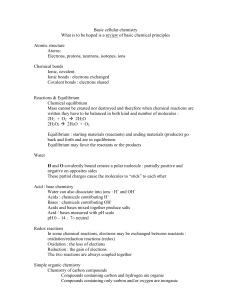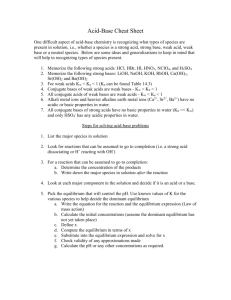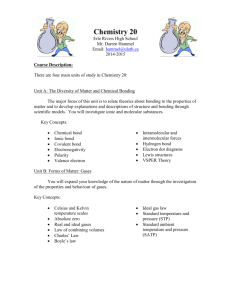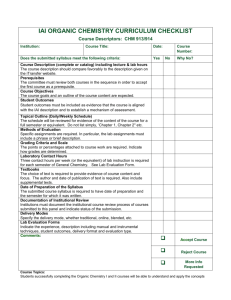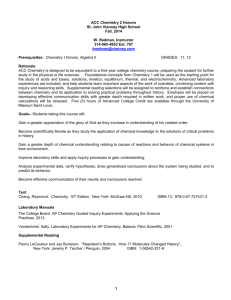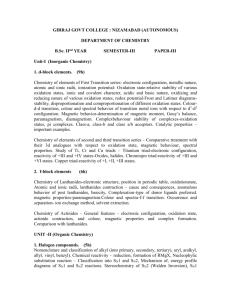SCH4U info sheet-2014
advertisement
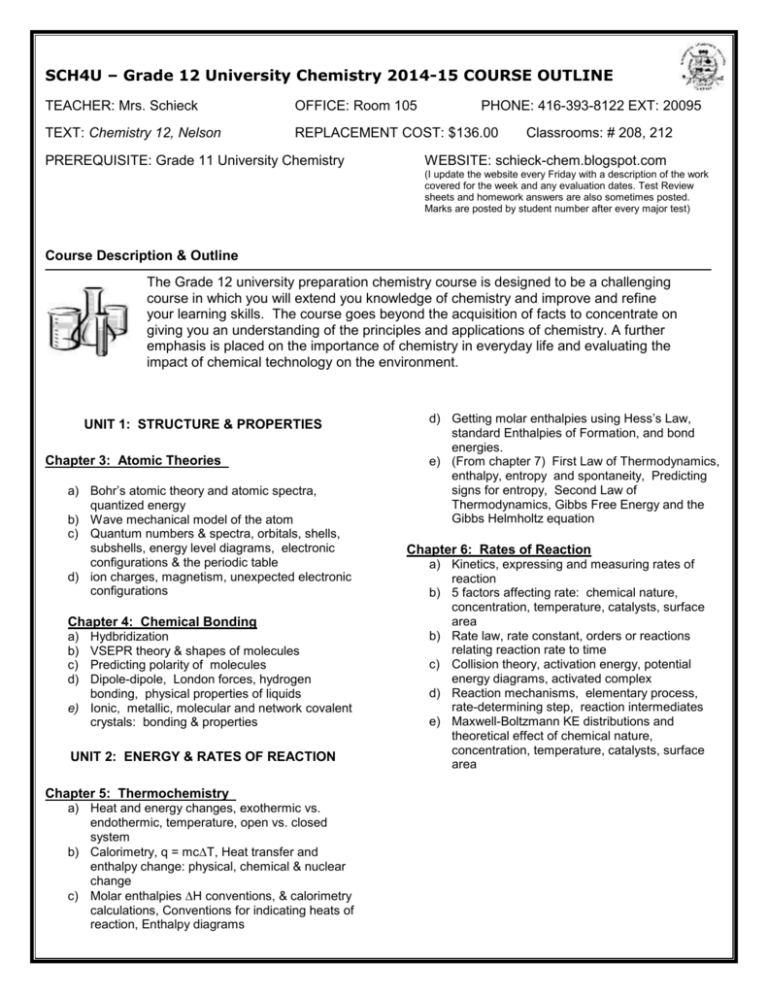
SCH4U – Grade 12 University Chemistry 2014-15 COURSE OUTLINE TEACHER: Mrs. Schieck OFFICE: Room 105 TEXT: Chemistry 12, Nelson REPLACEMENT COST: $136.00 PREREQUISITE: Grade 11 University Chemistry PHONE: 416-393-8122 EXT: 20095 Classrooms: # 208, 212 WEBSITE: schieck-chem.blogspot.com (I update the website every Friday with a description of the work covered for the week and any evaluation dates. Test Review sheets and homework answers are also sometimes posted. Marks are posted by student number after every major test) Course Description & Outline The Grade 12 university preparation chemistry course is designed to be a challenging course in which you will extend you knowledge of chemistry and improve and refine your learning skills. The course goes beyond the acquisition of facts to concentrate on giving you an understanding of the principles and applications of chemistry. A further emphasis is placed on the importance of chemistry in everyday life and evaluating the impact of chemical technology on the environment. UNIT 1: STRUCTURE & PROPERTIES Chapter 3: Atomic Theories a) Bohr’s atomic theory and atomic spectra, quantized energy b) Wave mechanical model of the atom c) Quantum numbers & spectra, orbitals, shells, subshells, energy level diagrams, electronic configurations & the periodic table d) ion charges, magnetism, unexpected electronic configurations Chapter 4: Chemical Bonding a) b) c) d) Hydbridization VSEPR theory & shapes of molecules Predicting polarity of molecules Dipole-dipole, London forces, hydrogen bonding, physical properties of liquids e) Ionic, metallic, molecular and network covalent crystals: bonding & properties UNIT 2: ENERGY & RATES OF REACTION Chapter 5: Thermochemistry a) Heat and energy changes, exothermic vs. endothermic, temperature, open vs. closed system b) Calorimetry, q = mcT, Heat transfer and enthalpy change: physical, chemical & nuclear change c) Molar enthalpies H conventions, & calorimetry calculations, Conventions for indicating heats of reaction, Enthalpy diagrams d) Getting molar enthalpies using Hess’s Law, standard Enthalpies of Formation, and bond energies. e) (From chapter 7) First Law of Thermodynamics, enthalpy, entropy and spontaneity, Predicting signs for entropy, Second Law of Thermodynamics, Gibbs Free Energy and the Gibbs Helmholtz equation Chapter 6: Rates of Reaction a) Kinetics, expressing and measuring rates of reaction b) 5 factors affecting rate: chemical nature, concentration, temperature, catalysts, surface area b) Rate law, rate constant, orders or reactions relating reaction rate to time c) Collision theory, activation energy, potential energy diagrams, activated complex d) Reaction mechanisms, elementary process, rate-determining step, reaction intermediates e) Maxwell-Boltzmann KE distributions and theoretical effect of chemical nature, concentration, temperature, catalysts, surface area UNIT 3: CHEMICAL SYSTEMS & EQUILIBRIUM Chapter 7: Equilibrium State a) dynamic equilibrium, forward vs. reverse reactions, solubility, phase & chemical equilibrium, % reaction at equilibrium, Equilibrium and G b) Equilibrium Law, Equilibrium constant, K & problem solving, Heterogeneous vs. Homogeneous equilibria c) Le Chatelier’s Principle & Concentration vs time graphs: temperature, concentration and gas volume changes, changes not affecting equilibrium: catalysts, inert gases d) Reaction Quotient & problem solving, Solubility Product constant Ksp, predicting precipitation, common ion effect Chapter 8: Acid-Base Equilbria a) Arrhenius Acids & Bases b) Bronsted-Lowry theory, amphiprotic/amphoteric, strong vs. weak acids, acids and their conjugate bases c) Dissociation of water, Kw, Strong Acids, Strong Bases, Kw, Hydrogen ion concentration & pH, pOH, pKw for strong acids and bases d) Weak acids and bases, % ionization, Ka, Kb, Organic bases, Ka x Kb = Kw, Calculations involving pH, Ka, Kb for weak acids and bases e) Lewis Acids & Bases f) Acid-Base titrations - strong acid/strong base titration curves, pH at the equivalence point and related calculations g) Buffers UNIT 4: ELECTROCHEMISTRY Chapter 9: Electric Cells a) oxidation & reduction, oxidation numbers & electron transfers b) balancing redox equations using oxidation number method, half reaction method c) predicting redox equations, oxidizing agent, reducing agent, use of redox tables, Left hand spontaneity rule d) Cells vs. Batteries, basic cell design, Galvanic Cells, Standard Cells & cell potential, the hydrogen half-cell, Consumer, commercial & industrial cells e) Corrosion & sacrificial anodes Chapter 10: Electrolytic Cells a) Electrolysis b) refining metals and electroplating c) Quantitative electrolysis calculations UNIT 5: ORGANIC CHEMISTRY Chapter 1: Organic Compounds a) organic vs. inorganic compounds, functional groups & multiple carbon-carbon bonds, hydrocarbons, aliphatics, alkanes, alkenes, alkynes, cyclics, aromatics, isomers b) nomenclature of alkanes, enes & ynes, benzene compounds, physical properties of hydrocarbons c) chemical reactions of hydrocarbons: combustion, substitution with halogens, addition (with H2, halides, hydrogen halides, water) & Markinov’s Rule d) substitution reactions of Aromatic hydrocarbons (with halides, nitric acid, alkyl halides) e) Organic Halides; nomenclature, properties, uses, preparation from hydrocarbons, elimination reactions Alcohols (1st, 2nd & tertiary); nomenclature, uses, properties, Reactions: preparation from hydrocarbons, combustion, elimination f) Ethers: nomenclature, properties, Reactions: preparation from alcohols (condensation) g) Aldehydes and Ketones: nomenclature, properties, Reactions; preparation from alcohols (oxidation), hydrogenation to form alcohols h) Carboxylic Acids: nomenclature, properties, Reactions: oxidation of aldehydes to acids, esterification, Esters: nomenclature, properties, Reactions: hydrolysis i) Amines: nomenclature, properties, Reactions: preparation from alkyl halides, Amides: nomenclature , properties, Reactions: preparation from carboxyl group + amine, hydrolysis j) polymers (addition & condensation) Further information about this course can be found at the Ontario Ministry of Education Website: http://www.edu.gov.on.ca/eng/curriculum/secondary/200 9science11_12.pdf Assessment and Evaluation Ongoing assessment will occur to allow students the opportunity to be successful. Students will be evaluated in four categories of the achievement chart. These will be in the form of quizzes, labs, tests, culminating lab activity and a compulsory final exam. Quizzes: At least one day of notice will be given. Labs: For most labs, the experimental data collection and the analysis are done in class in the form of a lab quiz. You cannot receive marks for an experiment you did NOT perform. Follow up with your teacher promptly regarding missed labs. During Course Final Mark Knowledge & Understanding of chemistry 35% 24.5 Ability to Communicate Chemistry 30% Inquiry & Analysis Skills 20% 14% Applications – Connections between Chemistry, Technology & Society 15% 10.5% Culminating lab activity Final Examination 21% 6% 24% 70% of final grade based on course work 30% final evaluation Tests: You will be given at least one weeks notice of a major test. You are expected to give the highest priority to writing all tests on the assigned day. Missing a test is a serious matter. Unless there are extenuating circumstances, no more than 2 makeup tests will be allowed to any student. Culminating lab activity: scheduled for late April (see school calendar), this four hour titration lab will be evaluated on the basis of experimental technique, lab results and a report and will be worth 6% of the final mark. Expectations - Students are expected to: attend classes regularly and be punctual. be respectful towards others and their property obtain and complete missed class work during absences come prepared and be ready to work do their homework on a daily basis. keep a complete set of notes be safety conscious at all times in the lab. (Back packs and coats are not permitted in class - see separate lab safety handout) Chemistry requires more understanding than memorization, and many of the concepts build on each other. It is essential that you keep up with the course. Discipline yourself to budget 35-40 min. every other day to do homework questions and review the lessons no matter what other tests or deadlines you have in other classes. If you apply this approach to all your classes you will reduce your stress and increase your success. Credit Rescue in Senior Science Courses: Credit Rescue is the prevention of course failure and loss of the credit. Due to the increased depth and breadth of the senior science courses, Credit Rescue does NOT occur after the final exam. For those students that performing at below 60 %, interventions will occur during the course that may include homework contracts, weekly teacher-student appointments, lunch tutorials or peer tutoring. This Credit Rescue intervention may be initiated by the teacher or the student. THE SCHIECK PLAN FOR SUCCESS: Spend at least 35-40 minutes on Chemistry after every class (every other day). 1. Complete any assigned homework questions or reading. (By the end of the assignment you should work towards being able to do it without relying on your notes.) 2. Spending some time reviewing your notes from the last couple of lessons. Good Ways to review: a) Writing is better than reading for review: Write some terms or questions on a piece of paper, and then close your book and try to answer/explain them. b) Try to teach a friend/sibling/parent about a concept you have learned. c) Do an extra problem that wasn’t assigned for homework d) Bring homework solution to Mrs Schieck during class or at her office to check for clarity and completeness 3. Stop by Mrs. Schieck’s office at lunch or after school for help if you are confused about something. Absences If you know you are going to be absent for an evaluation (appointment, field trip, sports event), then you must inform the teacher beforehand. The sooner you discuss the conflict, the more likely an acceptable alternate arrangement can be made. Failure to do so will jeopardize any consideration. Missed Action Student Should Take Regular Class Obtain notes, homework, and/or assignments from the teacher or a classmate BEFORE the following class. Quiz You must follow-up with the teacher and provide confirmation (parental note or parents call teacher or on an official field trip or team list) that the absence was excused. For most legitimate absences the teacher will not count the quiz or offer a make-up quiz. Test MISSING A TEST IS A SERIOUS MATTER. In the case of appointments that conflict with the test date, you must let the teacher know IN ADVANCE. The sooner you discuss the conflict, the more likely an acceptable alternate arrangement can be made. In the case of a sudden illness, the teacher should be informed as soon as possible and consulted the first morning of your return to school. For a legitimate absence for a test, a note specifically for me, explaining why you missed my test must be provided. It will be up to the discretion of the teacher as to whether a make up test will be offered. Lab You will not receive marks for an experiment that you have NOT performed. If you are absent for a lab, make arrangements to make up the experiment and evaluation ASAP. Lab experiments are time sensitive; as soon as the marked lab quizzes/reports are passed back, you can no longer make up the lab and may receive zero for the experiment. Plagiarism: Plagiarism is the act of taking ownership of written material or ideas belonging to someone else, whether knowingly or unknowingly. At Humberside Collegiate Institute, plagiarism is strictly dealt with. A student caught plagiarizing an assignment in this course will receive an automatic mark of zero. A second chance will not be granted. Deadlines: In accordance with the school’s policy on assessment and evaluation, any assignment or lab report handed in after the deadline will receive a penalty of 5% per day, up to a maximum of 10%. Exceptions for extenuating circumstances may apply at the discretion of the teacher.
